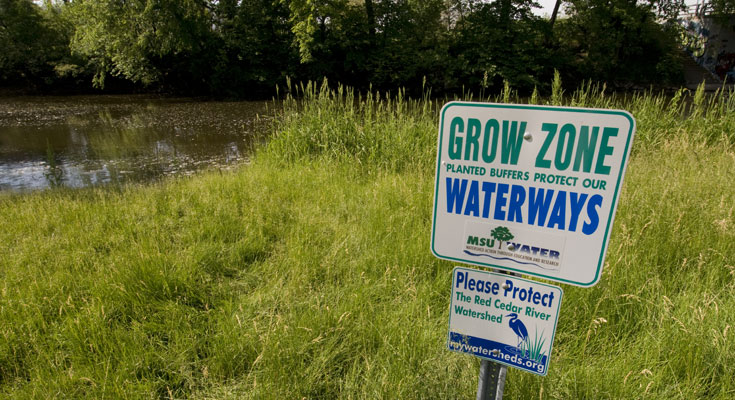Protecting and preserving our shared water resources
An iconic symbol on campus, Michigan State University's Red Cedar River is one of the most beautiful waterways in mid-Michigan. As one of the distinguishing features of the university, it has a rich history of environmental importance with MSU and local communities. MSU's commitment to sustainability is driving department experts, committee members and even students to develop innovative measures that protect and preserve our shared water resources.

Photo courtesy of Communications and Brand Strategy.
Take a step into the mid-1960s; industrial growth is strong, MSU is growing in size and admissions, and the agricultural developments on campus are rapidly increasing. With no regulation, stormwater runoff was collecting chemicals, sediments and farm waste on its way to drains that led directly into the Red Cedar. The river's water quality suffered dramatically, leading to sights of floating trash and pollution that harmed natural wildlife.
The passage of the Clean Water Act in 1972 was instrumental in addressing direct pollutant discharges to surface water and thus cleaning up the Red Cedar Watershed. It held industrial and governmental facilities accountable for their water runoff, ensuring that harmful pollutants could not directly enter water systems. Even though the new regulations tremendously improved the quality of campus water, MSU did not stop there. In 2003, legislation was passed to hold small to medium-sized urban areas accountable for their water runoff, and MSU not only complied, but rose to exceed the new water regulations.
Along the path to the Red Cedar, stormwater travels over roads, sidewalks, buildings and natural surfaces. In that process, sediment and pollutants can gather and eventually find their way into the river. In order to create a natural path for water during rain events, MSU's Stormwater Committee has developed several sustainable management practices on campus, better known as 'green infrastructure' or Stormwater Best Management Practices.
These systems mimic the natural environment and serve as an extra layer of filtration for water before it reaches the river. They also help limit the impact on our water resources by redesigning manmade surfaces for more conducive natural draining, "When working with water, it's much more a land issue. What we do on land impacts the water, so our focus is on what we can do on land to reduce the pollution that will inevitably reach the water," said Department of Community Sustainability Faculty member and Stormwater Committee member, Ruth Kline-Robach.
This move towards sustainable water management is spearheaded not only by faculty and staff, but also by students. In recognition of these efforts, Department of Horticulture students proposed and drafted a plan to install signs on campus at the location of various stormwater practices. Funded by the Be Spartan Green Student Project Fund, the signs are now part of MSU's new Stormwater Walking Tour program, a self-directed tour that anyone on campus can take to view these innovative practices.
Not only does MSU's commitment to improved water quality include modifications to campus infrastructure, but it also outlines a strategy of collaboration beyond the university's borders. "Water doesn't recognize boundaries, and therefore it is critical to work with surrounding communities on this issue," said Kline-Robach. MSU has partnered with the Greater Lansing Regional Committee for Stormwater Management on the "Pollution Isn’t Pretty" campaign, developed to spread awareness about the toxic properties that pet waste, fertilizer, motor oil and other pollutants can have on water.
Each piece of MSU's water protection plan is part of a larger initiative to create a connection between the beautiful water resources we enjoy and the efforts we should take to protect them. From developing green infrastructure to being mindful of campus waste, MSU has demonstrated that our land actions can positively impact our water resources. By raising awareness and implementing sustainable management practices across campus, MSU is actively working to engage local communities and improve water quality. These recent developments are just another part of the university's commitment to leadership in the area of water protection.

